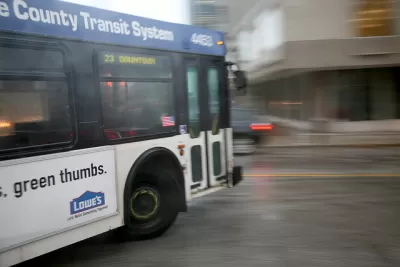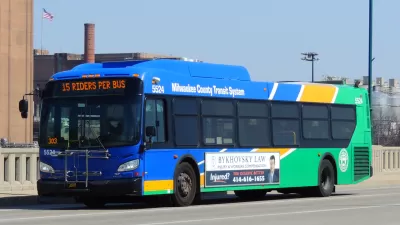A bus rapid transit proposal is still very much in the planning stages in Milwaukee, with the question of whether the route is allowed dedicated lanes along its entire length is still very much in question.

"[T]he Milwaukee Common Council unanimously approved restricting the use of dedicated lanes on a substantial portion of the county’s proposed East-West Bus Rapid Transit line," reports Jeramey Jannene.
The vote is one sign of discord over the project's planning at the city level. Alderman Robert Bauman, for instance, has criticized the planned route for the line, which would run for nine miles through Wauwatosa and Milwaukee "from a park and ride lot just northwest of the Milwaukee Regional Medical Center to the proposed The Couture tower on on [sic] the lakefront." Jannene allows Ald. Bauman an opportunity to look around the country for examples of BRT projects that Milwaukee should emulate.
Jannene followed up with Ald. Bauman, who is a staunch advocate for public transit, dating back to his earlier career, about other possibilities for the route. Ald. Bauman recommends the new BRT line follows the path of a light rail line proposed in 1996 as part of a failed regional system.
"The BRT project is seeking a grant from the federal government to fund up to 80 percent of its estimated $48 million cost. The project would be operated by the Milwaukee County Transit System," adds Jannene. The article also includes additional links for more background on the project.
FULL STORY: Council Approves BRT Route Restrictions

Study: Maui’s Plan to Convert Vacation Rentals to Long-Term Housing Could Cause Nearly $1 Billion Economic Loss
The plan would reduce visitor accommodation by 25,% resulting in 1,900 jobs lost.

North Texas Transit Leaders Tout Benefits of TOD for Growing Region
At a summit focused on transit-oriented development, policymakers discussed how North Texas’ expanded light rail system can serve as a tool for economic growth.

Why Should We Subsidize Public Transportation?
Many public transit agencies face financial stress due to rising costs, declining fare revenue, and declining subsidies. Transit advocates must provide a strong business case for increasing public transit funding.

How to Make US Trains Faster
Changes to boarding platforms and a switch to electric trains could improve U.S. passenger rail service without the added cost of high-speed rail.

Columbia’s Revitalized ‘Loop’ Is a Hub for Local Entrepreneurs
A focus on small businesses is helping a commercial corridor in Columbia, Missouri thrive.

Invasive Insect Threatens Minnesota’s Ash Forests
The Emerald Ash Borer is a rapidly spreading invasive pest threatening Minnesota’s ash trees, and homeowners are encouraged to plant diverse replacement species, avoid moving ash firewood, and monitor for signs of infestation.
Urban Design for Planners 1: Software Tools
This six-course series explores essential urban design concepts using open source software and equips planners with the tools they need to participate fully in the urban design process.
Planning for Universal Design
Learn the tools for implementing Universal Design in planning regulations.
Ascent Environmental
Borough of Carlisle
Institute for Housing and Urban Development Studies (IHS)
City of Grandview
Harvard GSD Executive Education
Toledo-Lucas County Plan Commissions
Salt Lake City
NYU Wagner Graduate School of Public Service





























